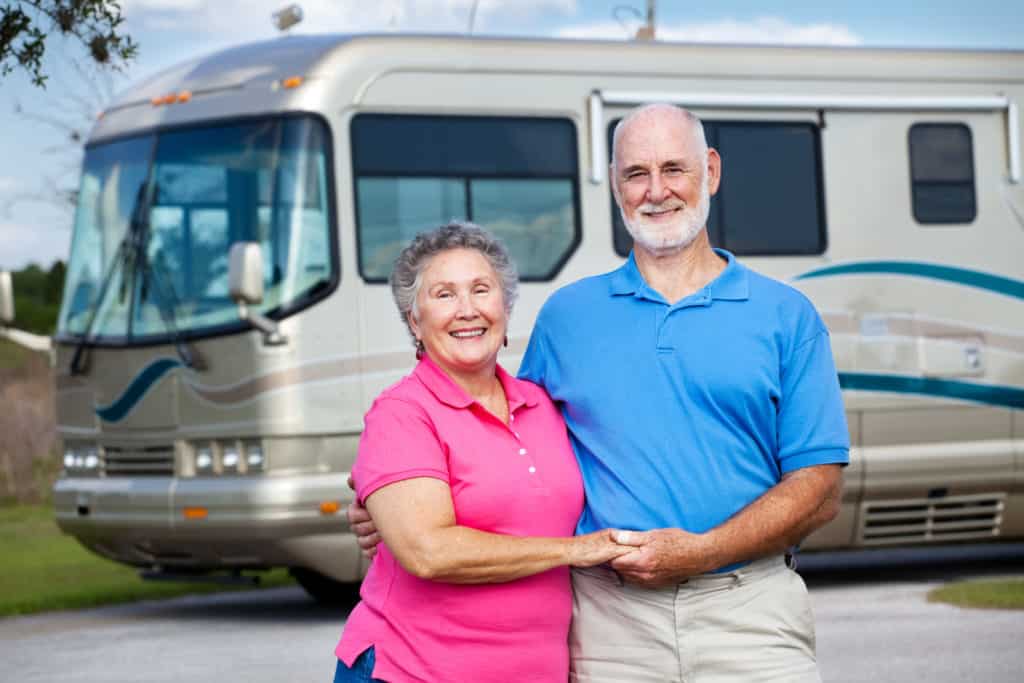
Growing older isn’t optional, but growing up is! That mantra should stay with you as you begin the process of finding your forever home in the form of 55+ communities. These retirement communities are designed with you in mind. But that doesn’t mean they are fully understandable when it comes to how they work.
How does over 55 housing work? Over 55 housing is a type of residential community that is created with the needs and lifestyle of people who are 55 and older in mind. If you are over 55 years old, you will need to apply to the community you would like to live in. If you are under 55 years old, there may be restrictions on whether or not you can join.
Because of this focus on specific details about the common demographic for their communities, most retirement neighborhoods cluster into a few different main types.
But before we can get into all of that, it should be explained as to what really constitutes a 55 years old or older community and some overlapping concepts you might encounter when searching for your very own forever home.
What Are 55+ Communities?
Any community that requires a minimum age of 55 years in order to purchase real estate falls under the category of 55+ Community. This includes any communities that exercise the “80/20” rule for their residences. The reason these communities advertise the age minimum is to emphasize the fact that the community is built around accommodating the needs of the specific age range.
It should be noted that some communities may advertise themselves as “senior-friendly” or “senior living” without actually requiring an age minimum to live there. These types of communities do not fall under the 55+ community umbrella as they allow for any age to live within their walls.
80/20 Rule
The 80/20 rule refers to a guideline dedicated to keeping the average age of a community to a minimum of 55 years of age. Plainly explained, the 80/20 rule states that in order to take residence in a 55+ community, 80% of the people living there must be a minimum age of 55. The other 20% can be made up of people who are under the age of 55.
It should be noted that most 55+ communities do not include the 80/20 rule. In fact, it is fairly rare for any type of retirement community to carry this rule outside of the state of Florida. This is mainly to cut down on quiet hour interruptions and to keep the communal feeling of being surrounded by your peers.
Types of 55+ Communities
There are many types of over 55 years of age communities that all have their own unique amenities dedicated to their residents. It is important to not only know the main differences between them but also research each community thoroughly before making a final decision on where to live.
Before listing the main types of communities you may encounter on your search for your own, there is a chance that some communities might be a continuing care retirement community or CCRC. This simply means that the individual can continue to live independently in their own homes, but a skilled professional may come to help care for them. These professionals can range from nurses to senior companions.
Even if a community has CCRC listed as one of the features it offers, it does not mean it is mandatory to participate in it to live there. It simply serves as another amenity offered by the community.
Luxury Communities
At the top of the list is Luxury 55+ Communities. in order for a retirement community to be considered “luxury,” the minimum monthly fee must be $1,500, and minimum housing cost must be $100,000. These communities tend to offer more opulent options and benefits for their members to enjoy.
Benefits of Luxury Communities
Luxury 55+ Communities have the most amenities available to their residents. Although every luxury community will be different, most carry the same overall benefits.
- Higher Security Measures- To keep their residents safe, luxury
communities typically have a higher level of security in the form of:
- Gates
- 24 Hour Security Services
- Entertainment Options- To keep members satisfied, some
luxury communities may host events designed to dazzle their residents!
- Guest appearances
- Live events
- Social events
- Game nights
- Healthy Living- Keeping their residents healthy in a high-class manner
is a top priority for most luxury communities.
- Spa
- Workout classes
- Fitness Center
- Pool
- Clubhouse Amenities- Some luxury retirement communities
might have a lot of their main features located in a specific area nicknamed
“the clubhouse.”
- Golf courses
- Tennis courts
- Restaurants

Drawbacks of Luxury Communities
All that being said, not everything within Luxury Retirement Communities is the best. There are quite a few disadvantages of living in these types of neighborhoods.
- Higher monthly fees- The benefits cost something, and
they cost a very pretty penny for Luxury 55+ Communities. There might be extra
fees tagged onto the already high monthly fee.
- Homeowner Association (HOA) fees
- Membership fees: Some luxury communities require you to purchase a separate membership to their clubhouse in order to use all the amenities.
- Dress code- Since they may offer social events or even in-community restaurants, these places may have a high-end dress code. Don’t be surprised if a lot of the events at a Luxury 55+ Community are black tie.
- HOA Requirements- Besides the HOA fees, the Luxury 55+ Community might also partake in HOA rules. This would limit your ability to customize the outside of your property and detail how your lawn can be trimmed.
Averages of Luxury 55+ Communities
Each luxury community is going to be different; however, here are the averages of cost, features, and look you will most likely encounter.
- Cost
- Monthly fee- $3,000
- HOA monthly fee- $150
- Entrance fee- $250,000
- Housing- $115,000
- Features
- Tennis courts
- Golf courses
- Fitness centers
- Spa
- Pool
- Grounds keeping
- Security
- Social events
- Walking paths
- Valet
- Beauty Services
- Restaurants
- Examples
College Town And University Communities
Similar to the college student life setting, University 55+ communities are retirement communities dedicated to furthering the education of its residents through established relationships with local colleges.
Advantages of College Town Communities
These communities offer higher education classes that can range from anywhere between biology to arts. Some might also offer the opportunity to take part in clinical studies, depending on the university they have a connection to.
- CCRC Living arrangements- These are living arrangements in
which either a senior partner or registered nurse helps the resident in their
daily functions.
- It still allows for independent living.
- College Courses- These 55+ communities
offer their residents a chance to attend college lectures and classes.
- There is an option to audit the class. This feature of the retirement community allows its residents to attend college courses for free!
- Dorm Settings- Most of these types of retirement communities are set up like college dorms. This allows for more intimate interactions between neighbors.
Disadvantages of College Town Communities
Although the main benefits of a University 55+ Community might be enticing, they do come with their own drawbacks as well.
- Living spaces- The living spaces are usually off-site of the main campus in order to continue the trend of residents being a minimum of 55 years old. This means commuting to these classes may be a requirement if you want to benefit from them.
- Commuting to classes- Because the living spaces are usually off-site, it would be required to have a means of commuting.However, because most of these types of communities are CCRC, they usually have the commuting aspect included in the monthly fees as well as assistance readily available.
- College classes- Although the audit feature allows residents access to free college classes, you won’t receive a college credit nor be required to take any exams.
Average Costs of University 55+ Communities
The auditing of classes will save you some serious cash in the long run. However, you still have to worry about all the other costs that come with a retirement community.
On average, you will be looking at a monthly cost of around $9,500. The benefit to this price is that these communities don’t require HOA fees and usually run off the bundle package idea.
A great example of a University Retirement Community would be Davis.
Retirement Park Communties
First and foremost, retirement parks are a type of 55+ community that covers both “RV 55+ Parks” and “55+ Mobile Homes.” The reason for this being that most 55+ Mobile Home communities leave spaces open for RVs owned by 55+ people looking to park their RVs for a while but not forever. Both of these communities go hand in hand with one another and typically share the same setup and strict rules.
Both retirement communities have similar functioning when it comes to their residents. Common spaces (e.g., walking trails, parks, roads, and other community areas) are maintained and monitored by the park owners and/or staff. The residents are therefore in charge of maintaining their own parking spaces (where their RV or mobile home resides). This keeps the monthly cost of living in the 55+ area lower than the other options.
RV 55+ Parks

These retirement communities are best designed for snowbirds or anyone 55 or over who is traveling and living out of their RV. RV 55+ Parks tend to have less to offer their residents in the form of entertainment and neighborhood, but they are still a great way to interact with people of your age and similar interest in travel.
The main focus of RV 55+ Parks is that residency is transient. With that in mind, most RV 55+ Parks do not allow mobile homes to reside within. Instead, the community is made up of continually changing neighbors that take up residency on a small plot of land.
55+ Mobile Homes
Like the RV 55+ Parks, these retirement communities focus on individuals owning or renting a plot of land in which they care for on their own. The main difference being 55+ Mobile Homeowners tend to stay within the community for a longer term than their RV counterparts.
Because the residents tend to be more long-term, these communities can offer more services and resources to their members. It also allows a better chance of establishing better connections with neighbors and the 55+ community as a whole.
Golf And Resort Communities
These types of 55+ communities try to offer an experience as close to a holiday vacation as they possibly can. Usually, these retirement communities create a space that is similar to the condominiums you would find in a timeshare resort.
They also tend to focus more on soothing entertainment values such as in house spas, workout classes like Tai Chi, walking groups, and other community-based activities. This heightens the overall communal feeling of the retirement area.
Of course, the biggest draw of the Golf and Resort 55+ communities is access to golf courses. Most, if not all, the golf courses are based within the gates of the community; however, some may have the golf courses slightly off campus and would need some form of travel. This is typically subsidized by the retirement community offering golf carts as a form of travel.
It should be noted that although these types of communities emphasize a feeling of resort and vacation style of living, they are not available to rent as vacation destinations. They are still retirement communities that have their own rules and regulations when it comes to visitors under the 55 year age minimum.
Active Senior Communities
Active Senior 55+ Communities are exactly what they say in the name: a retirement community focused around keeping their residents active and healthy. These types of retirement neighborhoods put more of an emphasis on physically engaging activities, while still being mindful of the needs of the community.
Because of this mindset, Active Senior 55+ Communities tend to have more walking trails, hiking options, swimming and water based activities, and other forms of outdoor activities available to their members. This does mean a possible higher fee than other communities in order to take advantage of their offerings, but it might be worth it to feel just as healthy as ever!
Other Less Common Retirement Communities
We are using the word “obscure” very loosely. These 55+ communities are typical around the United States, but they tend to fall outside the stereotype of what we think when we hear “retirement community.” This doesn’t mean they are lesser when it comes to services provided for their residents; it simply means they focus on an even more niche group of people and their needs.
Religious Specific Communities
Not only is there an age minimum, but Religious Specific 55+ communities also require their residents to be part of their respective faith. These retirement communities are great for those who have followed a specific religion and would like to continue in their formative years. It also opens up the opportunity to be surrounded by like-minded individuals that share your core values and religious upbringing.
Religious Specific 55+ communities make creating a safe space for the practice of their religion a priority above all others. This means there are more amenities and community events designed around the religious needs of the residents.
Single Only Communities
The term single Only 55+ communities does not necessarily mean “Single and Ready to Mingle” types of people. These communities cater directly to those who are 55 or over that are unmarried and live alone. As such, CCRC, or a similar program, is most likely offered.
Although it is not the main focus of Single Only 55+ Communities, some may offer social events and activities to introduce members to each other. However, the main goal of these retirement communities, as with the others, is to bring people together who are in similar living or lifestyle conditions.
Disabled Based Communities
Disabled Based 55+ Communities are any 55+ retirement communities dedicated to catering to the needs of those with a disability. These disabilities can range from mental, physical, emotional, and anything in between.
Although most of these Disabled Based 55+ Communities can focus on an array of ailments and the accommodations necessary for their residents, some may choose to only focus on one disability. It might not be as inclusive, but it does mean the community can provide more specialized facilities and care centers for their homeowners.
These retirement communities also offer CCRC living arrangements. More than not, these 55+ communities emphasize independent living without sacrificing safety. This does mean the cost of living might be higher than expected; however, most Disabled Based 55+ Communities do offer payment alleviation in the form of government aid.
Gated Communities
Although this category might extend to the previously mentioned types of retirement communities, Gated 55+ Communities are neighborhoods designed for those older than 55 that are surrounded by gates. These 55+ communities definitely offer more security and limit the number of visitors that come through.
That being said, it should be noted that Gated 55+ Communities have some of the most strict guidelines when it comes to living there, having visitors, quiet hours, and sometimes even dress codes when in common spaces. Some Gated 55+ Communities also partake in HOA and have rules regarding the exterior decorating of your residency. Be sure to familiarize yourself with these procedures before making any decisions.
How Do I Become a Member of a 55+ Community?
Each retirement community is going to have its own requirements in order to even apply to live there! But, under the umbrella term of “55+ Communities,” the first step in the application process is to be at least 55 years of age. From there, it varies depending on your desired living situation, retirement fund and/or monthly income restraints, and specific needs or wants from the retirement community. Below is a quick guide to get you started in the right direction.
- Research – You will definitely want to do extensive research on a number of retirement communities before committing yourself to just one. It is recommended that you hire a 55+ community-specific real estate agent to help you in this process.
- Meet with a representative – This will most likely be your forever community, so take the chance to meet with that 55+ community representative to get answers to all your questions.
Some questions you may want to ask are:
- Is this an age-restricted community or senior accommodating community?
- Are there any HOA fees? Are they yearly or monthly?
- What does my monthly fee include?
- Are there visitors welcomed to the community?
- Are the amenities included in my monthly fee, or do I have to purchase a separate membership to use them?
- Purchase property – Whether you are buying, renting, or parking, now is the time to purchase the right to be part of the 55+ community of your dreams!
Housing Options in a 55+ Housing Community
As discussed before, each type of retirement community will have its own way of establishing neighborhoods. More often than not, they will model the 55+ community after the already well-established setup of a modern community. This includes having rows of houses in a neighborhood that wind down to a clubhouse-like area with all the amenities the community has to offer. That being said, here are the three most likely living options you will have when you enter into a retirement community.
Houses
Most obviously is the typical house. Depending on the location and general pricing of the 55+ community, these houses can range from the $15,000 mark to $100,000 or even more! No matter the size or amount of bedrooms, one factor is still the same: it is a house in a neighborhood.
That being said, most houses inside a 55+ community are subject to HOA fees that might add to your monthly bill. They also tend to come with a lawn that will need to be attended to (although most retirement communities do offer lawn care within their package fees).
Apartment Complexes
If a full home sounds like a hassle, there are some 55+ communities that offer apartment complexes instead. Anywhere from a studio to a multi-bedroom setup could serve your needs better. This also opens up the opportunity for a more communal feeling as your neighbors are across the hall, rather than across the street.
This does subject you to the possibility of stricter quiet hour rules as well as the loss of a lawn/garden opportunity. There is also the chance that the apartment complex within the 55+ community does not offer access to the community amenities. Furthermore, it might be billed in the same manner as any other apartment complex, where the bills are separated rather than bundled.
Other Living Situations
As stated before, certain retirement communities allow for the individual to live onsite within an RV or mobile home. In these cases, the 55+ community will have its own list of requirements that must be met before living there.
There is also the chance that a retirement community will not carry the 55 year age minimum. These communities are typically labeled as “senior-friendly” and would be a better option for those that wish to live with their younger families.
Advantages of Living in a 55+ Community
Each and every retirement community will have its own advantages that they proudly display. However, the majority of these advantages can be summed up to the following list.
- Amenities- For most 55+ communities, they have their own hospitals, restaurants, shopping areas, and even some local attractions (such as parks) within their neighborhoods. All of which are designed to accommodate the specific requirements that come with age.
- Price breakdown- Everything necessary to live in the community is packaged into one large fee. So, there isn’t a need to pay your water, electricity, waste removal, or even taxes separately; rather, it is all bundled together into a monthly fee.
- Maintenance- This advantage creates less nuisance for their residents as they no longer have to worry about mowing the lawn or any other outside sprucing necessary.
- Like-minded neighbors – Because each type of community is clustered for a specific group of people, they are more likely to house people who share the same values and opinions.
- Decision involvement – Some retirement communities choose to host a Board of Directors made up and voted by the members of the 55+ community.This gives a direct representation of the community’s wants and needs.
Disadvantages of Living in a 55+ Community
Living in 55+ Communities does not mean everything will be sunshine and roses. They do still come with their drawbacks, regardless if they are luxury retirement communities or RV parking 55+ communities.
- Legal discretion – The main disadvantage of living in a 55+ community is that you are not protected under fair housing laws. This means you, or any of your guests, are not protected against discrimination based on race, color, national origin, religion, sex, disability, or family status.
- Homeowners Association – This association is almost inescapable when it comes to specialized communities. They require an extra fee, on top of your already monthly bill, that must be paid in order to continue to live within that 55+ community.
These fees can range from a few dollars a month to over $500 a year. There is also no average bar for how much of an influence the HOA has over a retirement community. It, and the fees, will vary from community to community.
- Community decisions- Along with the HOA, you are also at the mercy of the community as a whole. There might be strict guidelines that would prevent any improvements or customization of your home.
- Third party agencies- The community might also be represented by a third party agency.This could mean those in charge of making changes to the 55+ community would not be physically present within.
- Strict guidelines- These members and agencies may also create a strict rule book by which each resident must sign off on before living there. These typically include visitor restrictions, quiet hours, dress codes (when in common spaces), and anything else the 55+ communities deem valuable enough to force all its residents to agree to.
- Isolation- For ease of reducing noise levels, most of these retirement communities tend to build in more suburban areas. This does remove a lot of traffic from the residency, but it also isolates its residents from city life. Being so far away from main roads and public transportation may put a damper on any visiting family or friends.
Moving into a retirement community can be a bit daunting. It really is a life-changing decision as it will most likely be the last big move of your life! Because of that, it should be approached with the same caution and research as when you first bought a house.
Over 55 housing works in a lot of the same ways that buying any other piece of property would. The main difference is the expectations of the residents and the expectations from the community as a whole. Each community should be approached with the same questions and desires when you weigh the possibility of living there yourself.
